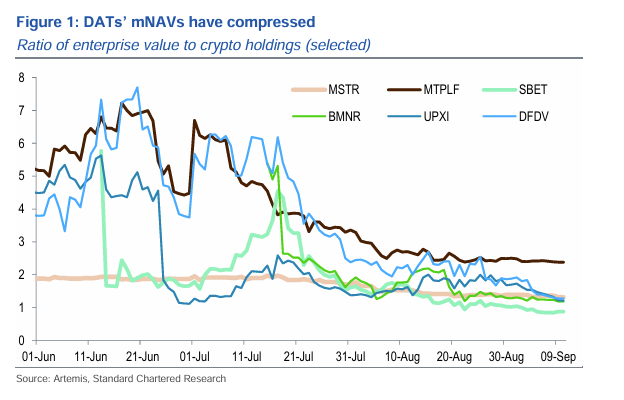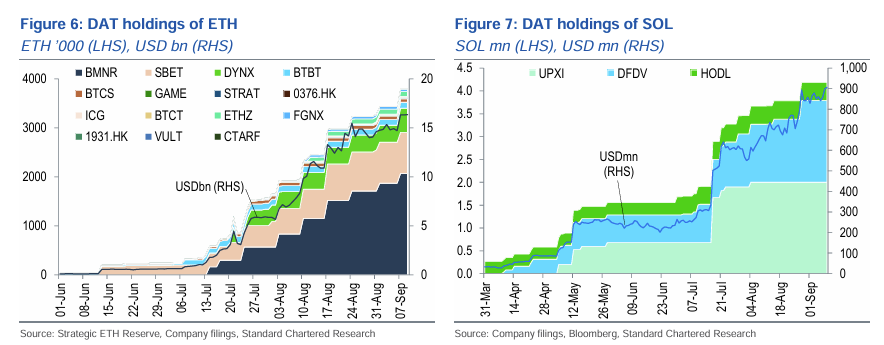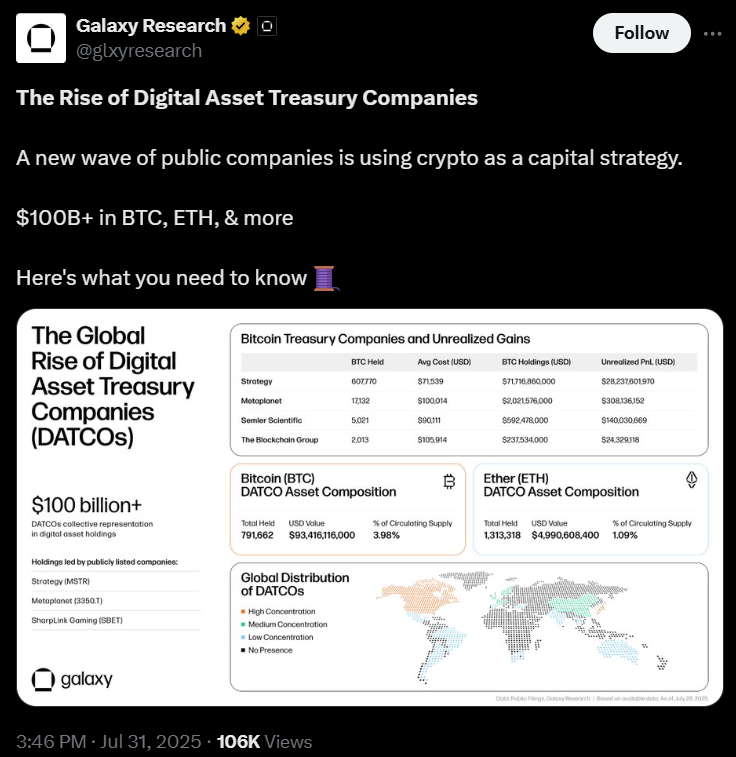Digital asset treasury companies are firms that hold cryptocurrencies as a central business strategy; recent mNAV compression has reduced many DATs’ ability to issue shares and buy more crypto, raising consolidation risk among smaller players while advantaging large, low-cost funders.
-
mNAV collapse limits share issuance and buying capacity for many digital asset treasury companies.
-
Large, liquid players with low-cost funding and staking yields are positioned to survive and consolidate the market.
-
Standard Chartered tracked widespread mNAV compression across firms including Strategy, Bitmine, Metaplanet, and others, driven by market saturation and investor caution.
Digital asset treasury companies face mNAV-driven risks; learn which firms may survive consolidation and what investors should watch next. Read analysis and next steps.
What are digital asset treasury companies and why are mNAVs falling?
Digital asset treasury companies are publicly listed firms that make cryptocurrencies the core of their balance sheet strategy. mNAV (market NAV) measures enterprise value relative to crypto holdings; falling mNAVs signal valuation pressure, limiting share issuance and reducing firms’ ability to accumulate assets.
How does mNAV affect a treasury company’s growth and survival?
mNAV above 1 lets a firm issue shares to buy more crypto; below 1, share issuance becomes dilutive and growth stalls. Standard Chartered’s research shows broad mNAV compression driven by market saturation, investor caution, and rapid expansion into Ether and Solana strategies. Strategy’s Bitcoin accumulation inspired dozens of imitators, increasing competition and compressing premiums.

Digital asset treasuries’ mNAVs have been under broad pressure since June. Source: Standard Chartered
Standard Chartered warned that the recent collapse in DAT mNAVs will likely trigger market differentiation and consolidation. Firms with deep liquidity, cheap funding sources and staking yields will be favoured. The bank tracked companies including Strategy, Bitmine, Metaplanet, Sharplink Gaming, Upexi and DeFi Development Corp and noted compressed valuations across the cohort.
mNAV suppression stems from several forces: market saturation as successful strategies are copied, rising investor caution, some unsustainable business models, and the swift expansion of Eth and Solana treasury strategies. Standard Chartered highlighted that Strategy’s early BTC accumulation spawned numerous imitators, intensifying competition for investor capital.

With the crypto bull market intensifying, DAT strategies have expanded beyond Bitcoin to include Ether and Solana, among others. Source: Standard Chartered
Why might consolidation accelerate among DATs?
Consolidation becomes likely when many small or mid-cap DATs trade at discounts to underlying crypto holdings. If mNAV remains depressed, larger players can acquire rivals to scale up holdings and preserve per-share crypto exposure. Standard Chartered suggests larger, low-cost funders could maintain aggressive accumulation by buying discounted peers.
Industry observers have raised similar alarms. Venture firm Breed cautioned that only a handful of Bitcoin treasury firms may avoid a “death spiral” triggered by falling mNAVs. NYDIG highlighted narrowing premiums between stock prices and underlying crypto holdings, and Greg Cipolaro of NYDIG cited investor anxiety over supply unlocks and increased share issuance as drivers of compression.

Source: Galaxy Research
Frequently Asked Questions
How is mNAV calculated for digital asset treasury companies?
mNAV compares a company’s enterprise value to the market value of its crypto holdings; an mNAV above 1 indicates the company can potentially issue shares to buy more crypto, while an mNAV below 1 makes share issuance dilutive and growth more difficult.
Which firms are most at risk from mNAV compression?
Smaller DATs with limited liquidity, high share issuance, or undifferentiated strategies face the highest risk; large firms with low-cost funding and staking yield—plus deep liquidity—are best positioned to survive consolidation.
Key Takeaways
- mNAV matters: mNAV above 1 lets DATs use equity to buy crypto; below 1 constrains growth.
- Winners and losers: Large, low-cost funders and staking-enabled firms are best placed to consolidate the market.
- Investor action: Monitor mNAV trends, share issuance, and funding costs when evaluating DAT exposure.
Conclusion
Digital asset treasury companies now face a critical test as mNAV compression limits the traditional growth lever of share issuance. Market saturation, investor caution and rapid strategy replication are key drivers. Watch liquidity, funding costs and strategic differentiation to identify firms likely to survive consolidation; COINOTAG will track developments and updates.
Published: 2025-09-15 | Updated: 2025-09-15 | Author: COINOTAG





